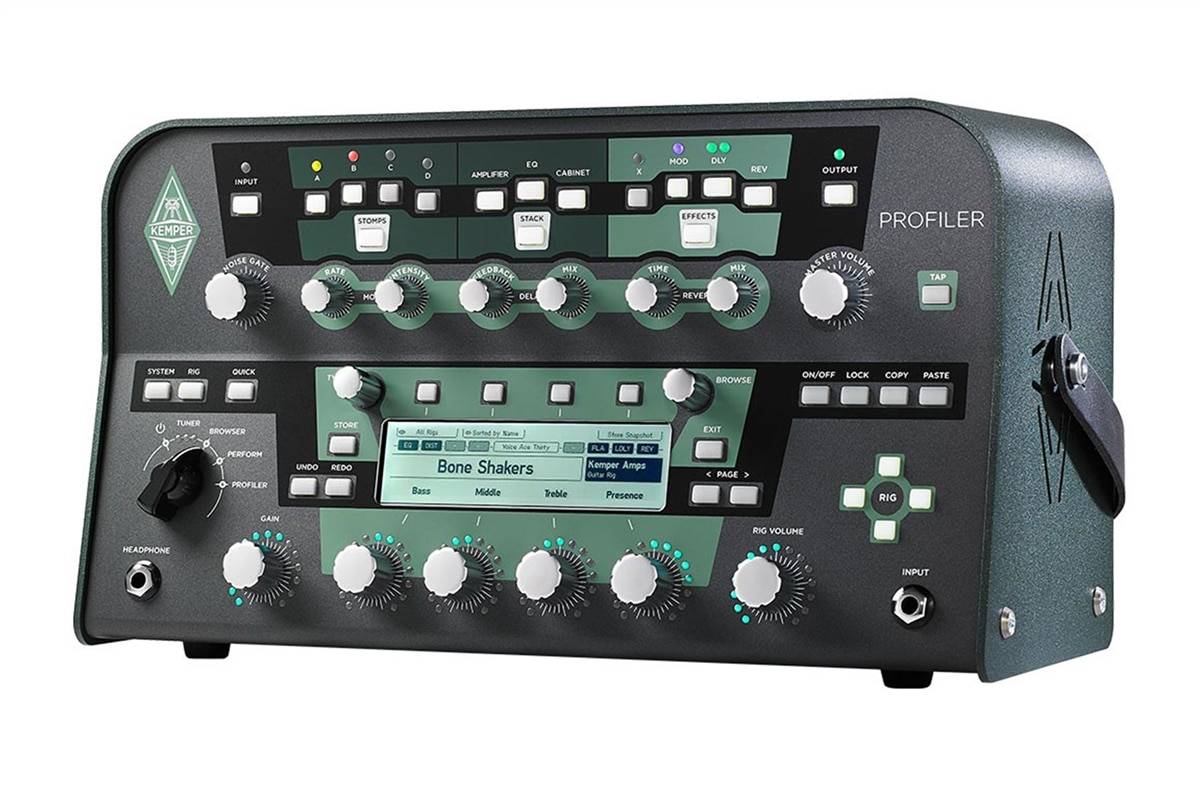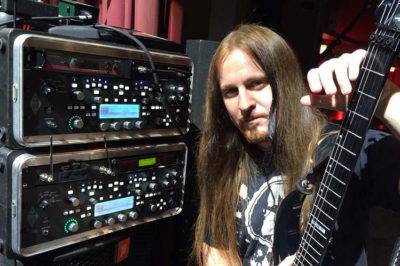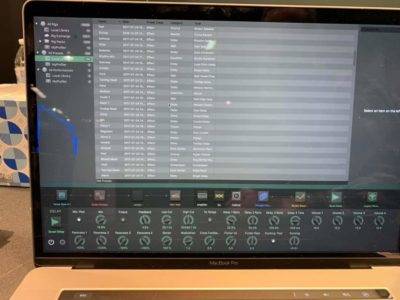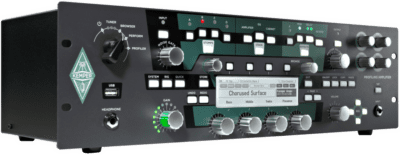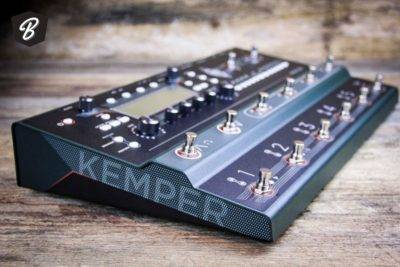Kemper Profiler Review
Making a Scene Reviews the Kemper Profiler
When you have owned a recording studio for as long as I have you tend to collect amplifiers as part of the tools of the trade. I have amassed a collection of “Tone Monsters” that run from a 1964 Fender Vibrolux Reverb and a 68 Super Reverb to Ampegs, Marshalls, Crates, and even a Pignose Cross mix! Guitar players are always looking for that magic tone for their recordings and a good studio has a collection that helps them find the sound they are searching for.
I recently had a session come into the studio for a singer/songwriter that had hired a session guitar player to come in and lay some tracks down. The player came in with his guitar and a small suitcase, which didn’t really strike me as anything out of the ordinary. It was when he pulls out this strange retro looking box with a collection of buttons and knobs that immediately struck my interest.
This session was my first experience with the Kemper Profiler, I was amazed at the quality of tonal colors that this unit was capable of. As the session progressed the session player cycled through different amplifier configurations and onboard effects and I could have sworn I was recording a well mic’d up Amp. Not to mention this was the first time a guitar player came into my studio and turned down the opportunity to plug into my 1964 Vibrolux Reverb!
This started a journey for me, one that had me exploring the what a Kemper Profiler was and why it sounded so good in the studio.
Amp Modeling Vs Profiling
I have had experience with many different amp modelers over the years. Some sounded acceptable some not so much. I always felt the sound of a real amp was always the better option, I never thought that many of the amp modelers were up to the task of replacing the sound of Tubes and Speakers.
The whole concept of modeling an amp is to “Model” the components of the amp as it moves through the signal chain. Which to me didn’t really give me the sound of the “Amp in the Room” sound.
This is where Profiling comes into play. The concept behind the profiler is much different than the an Amp Modeler. As most modelers, model the components of the amp, the profiler models the sound coming from the the amp, to the speaker, into the microphone and then through the preamp. The Microphone picks up not only the sound of the amp, but the cabinet and the room the amp is in. Through this signal chain you also get the color of that microphone and whatever preamp you are using as well. The result is a tonal quality that is a combination of all the components of the recording chain!
The Kemper Profiler Layout
At first glance at the Kemper you get the impression of a 1950’s tv Spaceship console packed into a toaster. But when you look deeper into it you realize it is laid out very logically.
On the top you have the “Stomp” section with 4 positions for various stomp effects, A “Stack” Section for choosing your Amp, EQ and Cabinet/Speaker, Then finally the “Effects” Section where the effects are in stereo (unlike the stomp boxes which are mono) and are divided up in 4 sections X (for Expression Effects), Mod, (For Modulation Effects), Delay and Reverb. Each have a collection of effects that can be loaded and saved as part of a “Profile” or a “Performance”. To list all of this is counter productive because everything in the Kemper is software based and their updates come pretty frequently with updates and added feature
The Lower Section contains your software controls as well as the tonal and parameter controls for the different “Rigs” you load in. .
This is a great video that runs you through most of the features on the front panel
Performance Mode
In addition to being a great sounding unit in the studio, the Kemper is uniquely designed for LIVE performance as well. You can save up to 5 separate Amp Rigs complete with Stomp boxes and effects as a preset. You can switch between the different rigs using the optional foot switch. The Foot Switch also allows you to turn the stomp boxes and effects on and off for each rig as well. This is a huge amount of versatility when it comes to a live performance. I was amazed at who was using the Kemper for live performances and as I was watch Axis TV I started to notice when I saw them onstage. Talk about bringing you “Studio Sound” to the Live Stage!
Profiles, Profiles and More Profiles
One of the amazing aspects of the Kemper Profiler is the sheer volume of profiles that are available for the unit. Included with the unit is a software program that connects to the profiler via USB and allows you to create a catalog of profiles and performances that you can edit and move to your Kemper Profile Unit. They also supply you with hundreds of professional profiles to start you off and you are also connect through the software to their user database of profiles which literally gives you access to thousands of additional profiles that have been created by Kemper Users and vetted by Kemper as being worthy of distribution. This gives you access to vintage and boutique amps you might never be able to get your hands on!
Creating Your Own Profiles
Then if that was not enough, you have the ability to profile any of your amps. The process is as easy as running your recording chain into the Kemper and instructing it to Profile the amp. It runs various white noise and sounds through the amp to get the base profile and you fine tune it by playing power chords through it to allow it to determine the proper profile setting. It’s is as simple as that!
Conclusion
As we mention at the beginning of this article my first exposure to the Kemper was during a studio session. I was so impressed with the sound and versatility of the Kemper Profiler I hunted one down and added it to my studio! It was a purchase that I have not once regretted. I can offer clients tones from amps that I could never justify purchasing as well as being able to isolate the guitar tone when recording a band from the floor. In the studio this is one of those units that clients scoff at until they plug into it. They can virtually call out just about any amp from a Fender Vibroking to a Dumble and with a click of a mouse I can have loaded and ready to go. You can add expression pedals, exterior stomp boxes, edit the sound, effects, stomp boxes to get exactly the tone and sound you want with little effort. But, I think the one thing that sells the client on the unit is how it responds to their playing style. The Kemper doesn’t just capture the tone of an amp, it seems to magically captures how the amp responds to how the player attacks the strings and their playing style. Two players can use the same amp profile and achieve different results. THIS is what makes the Kemper a valuable tool both in the studio and LIVE.
Since my initial purchase I have gone through at least a dozen updates to the unit, amassed a collection of over 22,000 profiles! One of the impressive policies of Kemper is the fact that they are constantly adding new profiles for their users as well as new updates and features. The best part is they do not and claim they will never charge their users for updates! FREE UPDATES FOR LIFE! Not bad at all.
The Kemper comes in several configurations; The Lunch Box unit (which also comes with or without an optional 600 Watt amp), The Rack unit (Also is available with or without a 600 Watt Amp) and the Stage (which is a foot pedal version of the profiler).
I started to profile my collection of vintage Amps and may start thinning out the herd sooner than later because I have their essential tones captured.
Discover more from Making A Scene!
Subscribe to get the latest posts sent to your email.





